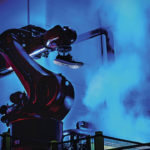 One of the central policy pledges made by Donald Trump was to reshore jobs that had previously moved overseas. Skepticism about his claims existed however, not least due to concerns that whilst work may return to the United States, the work would be done by machines rather than people.
One of the central policy pledges made by Donald Trump was to reshore jobs that had previously moved overseas. Skepticism about his claims existed however, not least due to concerns that whilst work may return to the United States, the work would be done by machines rather than people.
A recent study from Georg-August-Universitat Gottingen set out to explore whether reshored jobs were taken by humans or machines via a new measure of reshoring at the macroeconomic level.
The analysis found that high levels of automation in a country were positively associated with attempts to reshore production that had previously been moved abroad, but the logic behind this decision was not to give that work to humans, but to automate the work instead. As technology could do the job more cost effectively than even workers in cheaper locations abroad, it makes commercial sense to bring production nearer to the markets the products are ultimately sold in.
This resulted in a boost for the high-skilled workers who tend to work alongside such technology, but no such dividend for the lower-skilled workers whose jobs had ultimately been offshored in the first place.
Bringing work home
For instance, the addition of 1 new robot per 1,000 workers was associated with an increase in reshoring of around 3.5%. This was then linked with a boost in employment among professional occupations, with every 10% increase in reshoring associated with 1,150 new workers. Over the period of the research, this resulted in over 500,000 new jobs in professional occupations, but practically zero new work in elementary occupations.
The data shows that reshoring activity increased significantly between 2000 and 2014, which clearly predated the protectionist policies of the Trump administration. The trend largely occurs due to the changes in labor costs, with many Asian countries seeing rising living standards and therefore costs of labor. This coincides with greater efficiency and capabilities of robotic technology, which collectively makes adopting the technology more cost effective.
Sadly, the model produced by the team shows that protectionist measures increases the speed of reshoring, and therefore of the automation of work previously done by humans (albeit overseas). There’s no real evidence that tariffs help the lot of those whose low-skilled work was originally offshored.
With the march of technology unrelenting, the data provides further evidence of the importance of upskilling people as quickly and as frequently as possible, as that is really the only way to retain enduring value in the labor market. Alas, this long-term solution is seldom the one offered by populist politicians who are more attracted to short-term fixes.